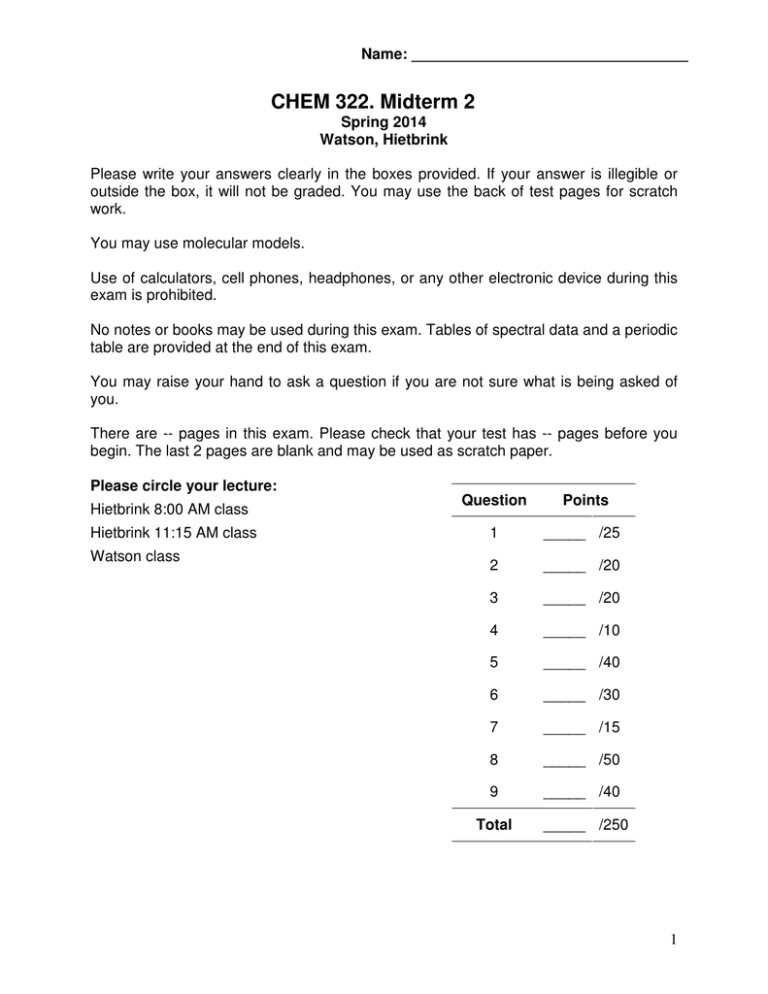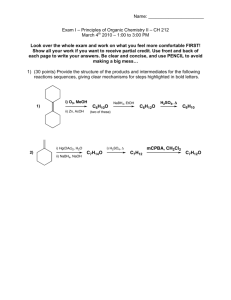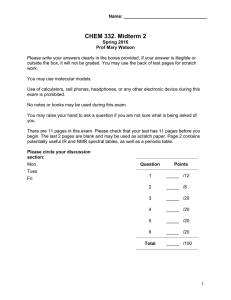CHEM 322. Midterm 2
advertisement

Name: _________________________________ CHEM 322. Midterm 2 Spring 2014 Watson, Hietbrink Please write your answers clearly in the boxes provided. If your answer is illegible or outside the box, it will not be graded. You may use the back of test pages for scratch work. You may use molecular models. Use of calculators, cell phones, headphones, or any other electronic device during this exam is prohibited. No notes or books may be used during this exam. Tables of spectral data and a periodic table are provided at the end of this exam. You may raise your hand to ask a question if you are not sure what is being asked of you. There are -- pages in this exam. Please check that your test has -- pages before you begin. The last 2 pages are blank and may be used as scratch paper. Please circle your lecture: Hietbrink 8:00 AM class Hietbrink 11:15 AM class Watson class Question Points 1 _____ /25 2 _____ /20 3 _____ /20 4 _____ /10 5 _____ /40 6 _____ /30 7 _____ /15 8 _____ /50 9 _____ /40 Total _____ /250 1 Name: _________________________________ 1. (25 points) Predict how many signals you would see in the 13C spectrum of each of these molecules. Put your answer in the box below the molecule. CH3 O Br Br O Br 2. (20 points) The 1H NMR of this compound should have four signals. Predict the splitting pattern (singlet, doublet, doublet of doublets, etc) you would see for each signal. H H Br H O CH3 H 2 Name: _________________________________ 3. (20 points) Below are the IR spectra for four of these eight compounds. Put the letter of the spectrum in the box below the appropriate compound. a) Spectra A and B refer to two of these four compounds. O OH OH N b) Spectra A and B refer to two of these four compounds. O OH NH2 3 Name: _________________________________ 4. (10 points) Below is the mass spectrum of 2-butanone. In the boxes, explain the large peak at 43 and the small peak at 73. 43 O 73 4 Name: _________________________________ 5. (40 points) Here are the IR, 13C NMR, and 1H NMR spectra for an unknown with the formula C6H10O2. Answer questions on the next page. C 5 Name: _________________________________ 5 continued. (40 points) These questions all refer to the spectra on the previous page. a) How many degrees of unsaturation are in this compound? b) Is there symmetry in this compound? c) In the IR, what does the signal at about 1740 suggest? d) In the 13C NMR, what does the chemical shift of the signal at about 105 suggest? e) In the 1H NMR, what does the chemical shift of the signal at about 5.2 suggest? f) In the 1H NMR, what does the integration of the signal at about 2.3 suggest? g) In the 1H NMR, what does the splitting pattern of the signal at about 1.0 suggest? h) What is the structure of this unknown? 6 Name: _________________________________ 6. (30 points) Draw what you would expect to see in the 1H NMR of this compound. Your drawing should clearly show the number of signals, their approximate chemical shift (within 1 PPM) and the expected splitting pattern. O H OCH3 11 10 9 8 7 6 5 4 3 2 1 0 7. (15 points) Draw the important resonance structures for this compound. O 7 Name: _________________________________ 8. (50 points) Predict the major organic product or products for the following reactions. O H2NNH2 KOH heat O excess CH3OH H+ O Li liquid NH3 Cl O2N Cl CH3O NO2 O O excess H2O H+ 8 Name: _________________________________ 9. (40 points) Please draw a reasonable arrow-pushing mechanism for the following reaction. H2O O H+ O OH 9 Name: _________________________________ Approximate IR Absorption Frequencies Bond O–H (alcohol) O–H (carboxylic acid) N–H C–H C≡N C≡C C=O C–O 1 Approximate H NMR Chemical Shifts Hydrogen δ (ppm) CH3 0.8–1.0 CH2 1.2–1.5 CH 1.4–1.7 C=C–CHx 1.7–2.3 O=C–CHx 2.0–2.7 Ph–CHx 2.3–3.0 2.5 ≡C–H R2N–CHx 2.0–2.7 I–CHx 3.2 Br–CHx 3.4 Cl–CHx 3.5 F–CHx 4.4 O–CHx 3.2–3.8 C=CH 4.5–7.5 Ar–H 6.8–8.5 O=CH 9.0–10.0 ROH 1.0–5.5 ArOH 4.0–12.0 RNHx 0.5–5.0 CONHx 5.0–10.0 RCOOH 10–13 –1 Frequency (cm ) 3650–3200 3300–2500 3500–3300 3300–2700 2260–2220 2260–2100 1780–1650 1250–1050 Intensity Strong, broad Strong, very broad Medium, broad Medium Medium Medium to weak Strong Strong 13 Approximate C NMR Chemical Shifts Carbon δ (ppm) Alkanes Methyl 0–30 Methylene 15–55 Methine 25–55 Quaternary 30–40 Alkenes C=C 80–145 Alkynes 70–90 C≡C Aromatics 110–170 Benzene 128.7 Alcohols, Ethers C–O 50–90 Amines C–N 40–60 Halogens C–F 70–80 C–Cl 25–50 C–Br 10–40 C–I –20–10 Carbonyls, C=O R2C=O 190–220 RXC=O (X = O or N) 150–180 10 Name: _________________________________ 1. (25 points) Predict how many signals you would see in the 13C spectrum of each of these molecules. Put your answer in the box below the molecule. CH3 O Br Br O 5 2 4 Br 4 6 2. (20 points) The 1H NMR of this compound should have four signals. Predict the splitting pattern (singlet, doublet, doublet of doublets, etc) you would see for each signal. doublet doublet H H Br H O CH3 singlet H doublet of triplets or triplet of doublets 11 Name: _________________________________ 3. (20 points) Below are the IR spectra for four of these eight compounds. Put the letter of the spectrum in the box below the appropriate compound. c) Spectra A and B refer to two of these four compounds. O OH OH B N A d) Spectra A and B refer to two of these four compounds. O C OH NH2 D 12 Name: _________________________________ 4. (10 points) Below is the mass spectrum of 2-butanone. In the boxes, explain the large peak at 43 and the small peak at 73. 43 This is the base peak, the most common fragment. This comes from cleaving one of the bonds next to the carbonyl to give this: O O 73 This is the M+1 peak. It is just the molecule (minus one electron), where one of the carbons is 13C. 13 Name: _________________________________ 5. (40 points) Here are the IR, 13C NMR, and 1H NMR spectra for an unknown with the formula C6H10O2. Answer questions on the next page. C 14 Name: _________________________________ 5 continued. (40 points) These questions all refer to the spectra on the previous page. i) How many degrees of unsaturation are in this compound? 2 j) Is there symmetry in this compound? no k) In the IR, what does the signal at about 1740 suggest? a C=O double bond l) In the 13C NMR, what does the chemical shift of the signal at about 105 suggest? an sp2 C m) In the 1H NMR, what does the chemical shift of the signal at about 5.2 suggest? H on an alkene n) In the 1H NMR, what does the integration of the signal at about 2.3 suggest? This is probably a CH2 o) In the 1H NMR, what does the splitting pattern of the signal at about 1.0 suggest? This group is next to two hydrogens. p) What is the structure of this unknown? O O 15 Name: _________________________________ 6. (30 points) Draw what you would expect to see in the 1H NMR of this compound. Your drawing should clearly show the number of signals, their approximate chemical shift (within 1 PPM) and the expected splitting pattern. O H OCH3 In this area there should be two doublets, a singlet, and either a doublet of doublets or a triplet. Exact order doesn't matter. 11 10 9 8 7 6 5 4 3 2 1 0 7. (15 points) Draw the important resonance structures for this compound. O O O O O O O 16 Name: _________________________________ 8. (50 points) Predict the major organic product or products for the following reactions. O H2NNH2 KOH heat O H3CO OCH3 excess CH3OH H+ O O Li liquid NH3 Cl O2N OCH3 Cl O2N Cl CH3O NO2 O NO2 O excess H2O O H+ 17 Name: _________________________________ 9. (40 points) Please draw a reasonable arrow-pushing mechanism for the following reaction. H+ H+ H2O O O OH O O OH H H H H O H H H+ O H O O H H H O O H O H 18






